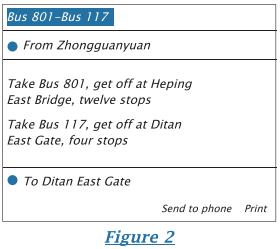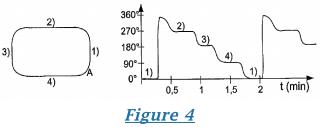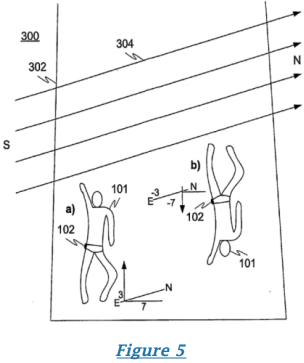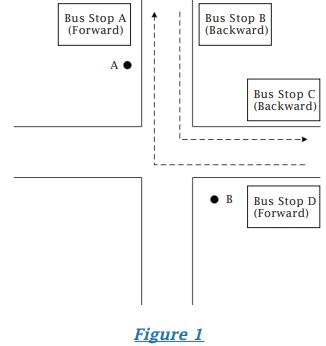During the substantive examination, the patent examiner must carefully read the application documents and strive to understand the invention accurately. The applicant shall also understand the reference documents provided by the examiner. However, because the expression of the text is not as clear as the actual object, the examiner will also have preconceived subjectivity in the understanding of the technical solution. As a result, the comparison and analysis of similar solutions will often involve their own subjective guesses, resulting in deviations, which may appear to be right but actually or to the contrary. This article will explain this through two actual cases.
"YES but No" Type of Misjudgment
Case 1 A method and system for reminding bus stations based on location services
Summary of the invention: At present, when passengers take a bus, they generally encounter the problem that they cannot find the correct bus stop. For example they may find the station to the opposite direction or there may be multiple bus stops in the same place. The existing scheme is to go to each bus station to confirm, which takes a lot of time. The invention accurately marks the position of the correct bus station by judging whether the direction information of the bus is consistent with the information of the forward direction of the passengers so as to avoid the mistake of going to the station to the opposite direction.
Independent claim 1 of the invention is as follows:
"A method for locating a bus stop based on location services, which is characterized by the following steps: 1. Obtain the passenger's current position information and terminal position information and obtain the passenger's forward direction information; 2. Obtain bus station information within a preset distance and obtain bus direction information according to the bus station information; 3. If the direction information of the bus is the same as the direction information of the passenger, indicate the location information of the bus station."
The related drawing is as shown in Figure 1. The arrows indicate the direction information (upward and downward) of the bus, and bus stops A and D can be obtained as the upward direction, and bus stops B and C are the downward direction.If the direction information of the bus is the same as the direction information of the passengers, the location information of the bus stop (such as bus stops B and C) is marked and provided to the user.
By analyzing the technical scheme of the present invention, it can be found that the present invention adopts the technical means of obtaining information of the bus in the same direction as the passenger and marking the bus stop, which solves the technical problem of preventing users from looking for the bus stop. While the examiner thinks that as long as the reference document discloses the recommended bus stop, it must be achieved by comparing the direction of the bus with the direction of the passenger and selecting the bus in the same direction as the passenger. Therefore, even if step 3 is not clearly recorded in the reference document, this is also its implicit technical content. reference document 1 (CN103592666A) is a GPS positioning and navigation method, which can obtain the bus navigation path according to the user's starting point and destination, and guide the user to the bus station, that is, it is disclosed that the user is guided to the bus station based on the bus navigation route, and then step 3 of the present invention is implicitly disclosed.
Regarding the understanding of the technical scheme of the present invention, it is believed in some view points that in reality, one finds a bus stop to the opposite is a problem with the personal sense of direction. In the navigation map, as long as you follow the directions on the map, you will surely be able to find the station accurately, and you will not go to the wrong direction. Therefore, the so-called problem of preventing passengers taking the wrong direction bus is not a real technical problem. In essence, it is still the navigation problem of how to travel from the starting point to the destination, which is the most basic problem in the navigation field. Therefore, step 3 of the present invention belongs to common knowledge. All common navigation software has this function, and there is no need to deliberately search and provide evidence for this feature.
There is also a view that how to prevent the problem of going to the wrong station is a special navigation problem, rather than a general origin-to-destination path planning problem. Marking the station location information by comparing the similarities and differences of the two directions information is exactly the invention of the present invention. Therefore, proof and comment must be provided, and the station prompt function in the general navigation map does not necessarily imply this feature.
A further analysis of the technical problem of the present invention reveals that it is actually to perform precise navigation and positioning of a starting point, rather than a general destination navigation and positioning. If the subtle differences between the two cannot be distinguished, it will be mistakenly judged that this scheme has been implicitly disclosed by a large number of reference documents or is common knowledge. The general navigation map does not automatically add a bus driving direction prompt to the starting station location. Although it is not difficult for general users to judge a reasonable stop based on the line direction and bus driving direction, there are substantial differences from judgment by users to automatic prompts by machines. Therefore, it is necessary to search for evidence. In the process of the initial feature comparison, it is believed that the reference document 1 implicitly discloses step 3 of the present invention, which is a "paradoxical" misunderstanding, degenerating the special problem to be solved by this application into a general route navigation problem, which is a unobjective view.

The examiner conducted a supplementary search for step 3 of the invention in claim 1 of the present invention and obtained the reference document 2 (CN102467545A). The technical problem to be solved by this document is: when a road has traffic in two directions, the user cannot determine which direction should be taken based on the query results, which may easily lead to errors in the ride. The technical method adopted is to first input the starting point and destination to query the route, then determine the positive and negative direction of the bus line according to the station on the bus line, and finally, the direction information of the starting station is determined and displayed through the correspondence among bus stops, the positive and negative directions of the station and the bus route direction information (see Figure 2). That is to say, the reference document discloses the technical scheme for obtaining the bus in the same direction as the passenger in the present application, which is essentially the same as the present invention in technical problems, technical features and technical effects. Therefore, it is a more objective way to replace this reference document as the closest prior art to dismiss the case.
"NO but YES" Type of Misjudgment
Case 2 A method and device for counting laps
Summary of the invention: In athletic events such as running, it is generally necessary for staff to count the actual number of laps completed by athletes, and the GPS lap counting method cannot be applied to indoor events. The invention judges whether the moving object has completed a circle of movement according to the angle between the initial orientation and the orientation during the movement of the moving object, without using GPS and can be used indoors.
Its independent claim 1 is as follows:
"A method for counting the number of laps, comprising the following steps: when receiving an instruction to count the number of laps, start to obtain the orientation of the moving object, wherein the first obtained orientation is the initial orientation of the moving object; when the angle between the obtained orientation and the initial orientation is greater than the first preset value and less than the second preset value, the number of laps of the moving object is increased by one."
The present invention considers the actual exercise process of the athlete in the playground or swimming pool, and counts the number of laps through two comparisons between the change of the moving direction during the exercise and the preset threshold (as shown in Figure 3).


After searching, the examiner obtained reference document 1 (US2006/0098772A1) . The reference document discloses a method for counting the number of laps, which also obtains the athlete's orientation during exercise, and counts the number of laps based on the obtained orientation change. The specifically disclosed embodiment of the elliptical trajectory lap counting is shown in Figure 4. The examiner regarded this reference document as the closest prior art, and in the notification of examination opinions, he believed that: reference document 1 discloses the number of laps based on the change in the direction of travel of a moving object, but did not disclose the “when the angle between the obtained orientation and the initial orientation is greater than the first preset value and less than the second preset valued” in claim 1. When the angle between the orientation and the initial orientation is greater than the first preset value and then smaller than the second preset value, the number of turns of the moving object is increased by one, but this feature is easy to think of.
The applicant’s observation is as follows: reference document 1 is to determine the number of laps at each turning point during the movement; however, this application does not need to determine all the turning points, but only needs to determine whether the change of the movement direction meets two preset values, and then a lap can be determined. Based on the opinion statement, the examiner preliminarily believes that there is indeed a difference between the present invention and the reference document when counting the number of laps, and the current reference document cannot deny the inventiveness of the present invention.
Further analysis of the technical scheme of the present invention can lead to different viewpoints: Claim 1 of this application defines that when the angle between the acquired orientation and the initial orientation is “greater than the first preset value” and the angle between the orientation acquired afterwards and the initial orientation is “less than the second preset value”, a lap is counted. The two “angles” reaching the prescribed changes are all caused by the change of direction. Therefore, it is essentially to judge whether there are two change points. The implementation of the swimming lap based on the back-and-forth trajectory disclosed in reference document 1 is as follows: first obtain the initial direction of the trainer, set the starting point of the trainer as the starting point of side a), and the direction angle of side a) is about 293° , When the swimmer reaches the side b), the direction angle is 113°, it is determined that the direction change angle of the two exceeds the predetermined limit, that is, the direction changes once; when the swimmer reaches side a) again, that is, when the direction angle becomes approximately 293°, it is determined that the direction change angle again exceeds the predetermined limit, that is, the direction changes again, which can be counted as a lap (Figure 5) . Therefore, the embodiment in the reference document 1 also counts the number of laps by comparing the change of the traveling direction with the preset threshold twice during the movement, which can be used to deny the inventiveness of the present invention.

After comparison and analysis, the difference between the embodiment in the reference document 1 and the claim 1 of the present invention is that the technical feature is only the judgment criterion. Claim 1 uses the initial direction as the reference, while the reference document 1 uses the movement direction at the previous moment as the reference. Although the criteria for the selection of the two are different, they are both determined by judging two significant changes in direction to determine a circle. The inventive concept is the same, and whether the initial direction or the direction at the previous moment is used as the judgment criterion is an equivalent common technique. means. Claim 1 of this application is a relatively high-level summary. The embodiment shown in Figure 3 in reference document 1 is a specific disclosure of this high-level summary. Although its description method is obviously different from that of this application, it is different from that of this application. The inventive concept is exactly the same, and the actual effect is similar, so it does not constitute a substantial difference.
In the end, the examiner rejected the present invention based on the example of swimming laps in reference document 1. After the rejection, the applicant filed a request for reexamination with the same reason and did not modify the claims. The review decision remains rejected, indicating that the review conclusion is relatively scientific and reasonable.
How to grasp the non-obviousness caused by subtle differences
Regarding creativity, the core of the "three-step method"1 judgment of China's Patent Examination Guidelines is "whether it is obvious." However, Article 103 of the US Patent Law directly uses the word "Non-obviousness"2 to express the concept of creativity. Paradox is the difficulty of patent examination and patent application. Therefore, the author combines the above two cases from the perspective of the examiner and the applicant and summarizes how to grasp the non-obviousness caused by the subtle differences between similar schemes.
1. Looking at the invention as a whole
Section 3.1 of Chapter 4 of Part II of the Guidelines for Patent Examination (2010) stipulates: “When evaluating whether an invention is creative, the examiner must not only consider the technical scheme of the invention itself, but also consider the technical problem to be solved by the invention and the technical effect produced, and treat it as a whole.”3 It can be seen that the interpretation of the technical plan must not only consider the key technical means in the technical plan, but also consider the technical field and technical problems, and combine these three elements in order to grasp the essence of the invention as a whole. For example, the technical problem of the aforementioned Case 1 is: to prevent mistakenly going to the bus station to the opposite direction. In fact, it is to solve the problem of inaccurate positioning of the starting point for navigation and positioning, rather than the problem of route navigation in the general sense. If the subtle differences between the two cannot be distinguished, the intent of the invention will be distorted, resulting in the misunderstanding that this scheme has been implicitly disclosed by a large number of reference documents or the common knowledge in the field, leading to problems such as improper proof and far-fetched reasons for creative comments.
2. Stating rational and analytical opinion
During the review process, it is necessary to fully understand the applicant’s statement of opinions and find out whether the various advantages and advancements in the statement of opinions can be directly reflected in the original application document. When judging the inventiveness, it is necessary to consider the applicant’s statement of opinion and objectively interpret the original specification and conduct independent analysis from the perspective of the field, and cannot be influenced by the applicant’s statement of opinion. For example, in the aforementioned case 2, it was initially believed that the origin of the invention’s creative misjudgment was affected by the statement of opinions. However, after objectively studying the original specification, it was found that the lap counting principle of the present invention is the same as that of the reference document, and both count the number of turns through two changes of direction.
In short, in the judgment of inventive step, it is necessary to strictly follow the record of the original specification, carefully infer the inventor’s intention and the improvement of the invention, keeping consistency of the judgment throughout the examination process, rather than being influenced by the applicant’s observations, so that we can make an objective and fair judgment on whether the subtle differences in similar schemes lead to non-obviousness.
The applicant's perspective
1. Clarifying the intention of the invention
The applicant should clarify the invention intentions and ideas of the application, confirm the technical problems solved, the technical means adopted, and the technical effects achieved. When understanding the review opinions of the examiner, the applicant should judge whether the reference documents have solved the same technical problems by using similar technical means, and then judge whether the review opinions are correct. If the review opinion is not correct, you should find out the technical support content that makes the difference based on the difference between this application and the reference document, and make a reasonable refutation of the review opinion.
As in the aforementioned case 1, the technical scheme disclosed in the reference document 1 given by the examiner for the first time did not solve the technical problem of the application, and did not further disclose the key technical feature that solves the technical problem in the application, namely step 3. It is obviously incorrect to consider that the feature is implicitly disclosed. If the applicant can find the subtle difference from a technical point of view, it can effectively state the non-obviousness of the application relative to the reference documents.
2. Comparing the essence of the technical plan and responding effectively to the review opinions
The applicant should compare the essence of this application with the plan of the reference document, and should not stick to the comparison of written records. After determining the difference between this application and the reference document based on the essence of the technical scheme, the potential innovation of the difference should be analyzed to confirm whether the difference involves the development and improvement process of the invention, and then make an effective observation.
As in case 2, although the written records of the technical schemes in this application and the reference documents are obviously different, the essence is the same. The applicant did not grasp the substantial differences when understanding the technical schemes, and furthermore, there were deviations in confirming the different technical features and made many invalid statement, which eventually results in the rejection of the application.
In short, in the process of patent application, the applicant must also clarify the invention intention and ideas, and accurately judge the substantial differences between similar schemes based on the records of the reference documents given by the examiner, and correctly judge whether the subtle differences of similar schemes lead to non-obviousness, and then gives a reasonable response to the review opinion, and strives to obtain authorization for its application.
Note:
1. China National Intellectual Property Administration, 2020. Patent Examination Guidelines. Intellectual Property Publishing House. pp172-173.
2. World Intellectual Property Organization, 1992. Intellectual Property Talks. Beijing: World Intellectual Property Press. p85.
3. China National Intellectual Property Administration, 2020. Patent Examination Guidelines. Intellectual Property Publishing House. P171.









